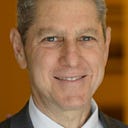the implications of Douglas Harding’s pointing experiment
Vic Shayne
author
13 Pillars of Enlightenment: How to realize your true nature and end suffering
Douglas Harding was a unique mystic who, at age 98, left us way too soon. One of his hallmark teachings was a particular “experiment” (his descriptor) that he devised for people to get a feel for what they are beyond their bodies and senses of self. I suppose it can be said that it was a literal and metaphorical way to get out of one’s own head. Harding called this the pointing experiment and it is still readily taught by his protege Richard Lang and his Headless Way organization. Lang’s goal is to show anyone who is interested, instantaneously, what they are devoid of the egoic self, body, mind, and thoughts.
I shall leave it to the reader to watch Lang’s demonstration of the pointing experiment instead of describing it here in this article. If you have tried the experiment for yourself then what follows should make more sense…
Regarding Harding’s pointing experiment, consider this: When you point to where your head should be and ask yourself “What am I pointing at?” you may realize that you are the capacity that holds the entirety of the world and all phenomena. All is contained within this capacity — except the real you.
While you can name and see everything else that you point to except for your own head, Harding asked us to ask ourselves what, on present evidence, we are pointing to.
present evidence of what ‘is’
The phrase that Harding used so often — “on present evidence” — is one deserving of meditation. In the absolute now, the present, there is no thought at all. And because when there is no thought there is also no self. If we can observe “what is” based only on what is available to us in the eternal now, right now in the present, then we find something quite amazing. It is only when we bring in knowledge and thought, which are only of the past, that we make assumptions and declarations about ourselves and others. This means that we, the persons we take ourselves to be based only upon what we have been taught by others, are no more than beliefs: We assume that we know who we are because we have accepted ideas from others to form such a conclusion. However, what we really are cannot be explained, experienced, or determined by anyone but ourselves, each of us personally.
is it metaphorical or literal?
The pointing exercise crosses the boundary from the metaphorical to the literal. Only because we have learned that we have a head — an identity based on appearances, interests, associations, thoughts, memories, and so on — can we claim that we are pointing to our head, face, and features. But are we really pointing to anything, or are we really a void, a capacity that contains all that we can sense and know? When we do not bring what we believe we know into the equation, the mind is often stunned into a state of no thought, which is the intention of the experiment. Leave the past behind, which includes all that you know, and then consider who you really, really are based only on present evidence.
what are the implications?
When pointing at ourselves, where our head should be, on present evidence we have no physical senses to inform us of what we are, even if we wanted to rely upon such knowledge. It seems that it would take a mirror or reflection to inform us, but Harding reminds us that that mirror image over there at arm’s length is not who we are right here where all the looking and sensing is taking place.
Now, let’s take this further and apply this to listening and responding to our world. Just as we do when the mind goes blank as we are pointing to the headless space, can we have this same response when someone asks us a question or when an incident occurs? What if we took everything into this emptiness in the same way that a black hole swallows all information and phenomena without any bias or intention? All answers are within this black hole: When the mind is nothing but a capacity to receive, an answer merely arises from this capacity. The very definition and concept of listening is different from what we are used to, which is to use logic and memory — an intellectualization — to judge and fashion an answer.
Perhaps the word “listen” needs to be explored in a new light as a listening that is an unalloyed as it receives a question or observes an incident. The headless way offers us an opportunity to receive so that what we give back is a natural response and not one that is premeditated or conditioned or sullied. What, then, could be the degree or depth of such listening? It’s up to you to find out for yourself.
The headless way experiment teaches us that in this direction where our head should be there is nothing but capacity, a complete silent stillness, a spaceless space that contains everything, including the question we are being asked, the phenomena taking place, and the answers to everything. The mind, as the Taoists say, is an empty vessel and all beings, phenomena, and the rest of reality are but reflections of ourselves as the Tao. The Tao itself, when intellectualized, becomes known within the capacity discovered by the headless way.
